| 020
|
About the PROJIMO Team
Many of the innovations described in this book were developed at PROJIMO,
the village rehabilitation program in the mountains of western Mexico. As we
explained in the Introduction, the program is staffed mostly by young
disabled villagers. Because you wiil meet PROJIMO team members in various
chapters, we thought you might like to know a bit about them. Most come from
poor families and have lived through very difficult times. They first came
to the program for their own rehabilitation, then decided to stay longer,
learn new skills, and work together to help others. Many speak of their
experience at PROJIMO as a kind of liberation or even a "return to life."
Each has a fascinating story. Here we will say only a few words about some
of the key members of the team.
MARI AND ARMANDO.
Mari Picos is one of the coordinators of PROJIMO. She was paralyzed from
the waist down (paraplegic) in a car accident on her honeymoon. For two
years she stayed in a dark room, unwilling to accept her disability or
use a wheelchair. Twice she tried to kill herself. She was first taken
to PROJIMO against her will. But in the course of her own
rehabilitation, her heart went out to some of the disabled children.
Eventually she became one of the leaders and organizers of the program.
She became skilled at evaluating disability needs, peer counseling,
brace-making, and at treating medical problems such as pressure sores,
urinary infections, and epilepsy. She married Armando, now runs her own
home, and they have a delightful daughter, Lluvia (meaning rain). |
 |
 |
Armando Nevérez had polio affecting all four limbs, Doctors said he
would never be able to walk. But they were wrong. PROJIMO helped him to
get surgery and to begin to walk with leg braces and crutches. Armando
became a skilled brace maker and now runs the wheelchair shop. He
married Mari and usually treats her as an equal (which makes him
exceptional in more ways than one). |
CONCHITA AND MIGUEL.
Conchita Lara became paraplegic from a fall when she was a teenager. For
4 years she was totally dependent on her family and very depressed. At
PROJIMO, in her words, she "returned to life." Today, with Mari, she
helps coordinate the program, makes artificial limbs, and does the
program's accounting. She married Miguel Zamora, who is a driver and
handyman for the program. They have two lovely children. Conchita's
story is told in Chapter 42. |
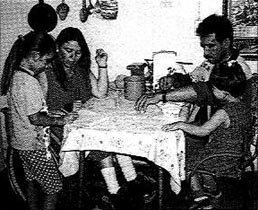 |
|
| 021
|
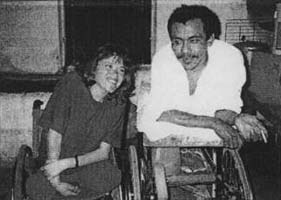
IRMA AND JAIME.
Irma Llavió had polio as a baby. With all four limbs affected, she spent
her childhood and adolescence crawling about on the floor, and she never
left home. She was brought to PROJIMO by Martha Heredia, a leader in
Mexico's budding independent living movement. For Irma, getting her own
wheelchair and being with a group that treated her as an equal was
liberating. She runs the kitchen, works in the toy shop, and helps her
boyfriend, Jaime, in the wheelchair shop.
Jaime Torres, who is paraplegic and rides a wheeled cot because his
hips are fused straight, has been working at PROJIMO for 6 years. For
the first years he was chronically depressed, and sometimes he was drunk
for days at a time. Then Irma arrived, and Jaime's spirit revived. He
has become a master welder and wheelchair builder. |
ROSA.
Rosa Salcido, an older woman, is in some ways the heart of the program.
One of the few non-disabled workers at PROJIMO, she is the personal
attendant for most of the children and adults who are unable to care for
themselves. Without children of her own, she has become a sort of
universal mother, treating even the most difficult children with love
and patience far beyond the call of duty. (See
Chapter 32.) |
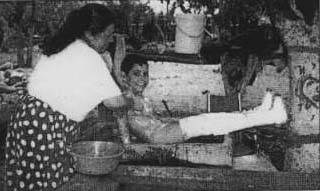 |
 MARCELO. MARCELO.
Marcelo Acevedo is one of the founders and leaders of PROJIMO. He had
polio as a baby. Since his early childhood, the program has helped him
with braces, crutches, and schooling, and trained him as a village
health worker. He has become a very skilled, innovative brace and
artificial limb maker, as well as a welder and wheelchair maker. Marcelo
is one of the main trainers of others in these skills. I (the author)
have Marcelo to thank for walking as well as I do today (see
Chapter 11). Good-willed and gentle,
Marcelo is often the peacemaker when conflicts arise. Marcelo (on the
left) teaches Armando to make plaster molds for braces. |
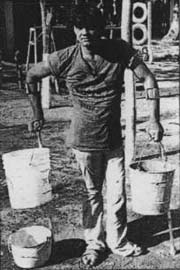
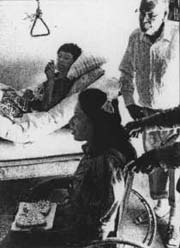
INEZ AND CECILIA.
Inez Leon has one leg paralyzed by polio but is incredibly strong.
Having grown up as a street child, in his teens he was brought to
PROJIMO, and stayed. Trained in a hands-on way by Ann Hallum and other
physical therapists, Inez has become a skilled therapy helper. After a
long courtship he and Cecilia married and now have two little girls.
Cecilia Rodriguez, who also had polio and uses a wheelchair, tutors
disabled children and teaches them arts and crafts. |
|
| 022
|
 MARIO. MARIO.
Mario Carrasco was born in a mountain village, but grew up on the
streets of a coastal city. His involvement in drug trafficking led to
the bullet wound that paralyzed him from the waist down. Angry and
violent when he first arrived at PROJIMO, he became one of the most
caring and capable workers there. (See Chapters
43 and 44.) |

MARTÍN.
Martín Pérez, like Mario, grew up on the city streets in the subculture
of drugs and violence.
When he was 16 years old, Martín was shot by a gang rival and became
paraplegic. At PROJIMO his fits of anger caused problems and sometimes
brought Mari and Conchita to tears. But he became a very gifted
wheelchair designer and builder. And he was very caring and helpful with
the children who were most in need of attention and love. His work on
creating a one-arm-drive wheelchair has been interrupted now by years in
jail for trying to smuggle marijuana to his brother who was already in
prison. (See Chapters 37 and
39.) |
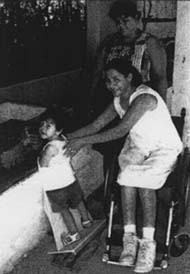 MARIELOS. MARIELOS.
If Rosa is the heart of the program, Marielos Rosales is the princess.
Paralyzed in her lower body from a car accident, she was brought to
PROJIMO for rehabilitation, then became involved in the toy-making shop,
and now produces such beautiful play-things that she has more orders
than she can fill. She also makes special seats, standing frames, and
other wood and cardboard equipment for disabled children. When she does
not have too much pain in her legs, she sings constantly and lifts
everyone's spirits with her grace. |
 POLO. POLO.
Polo Ribota was 13 years old when his father was killed. He has become
and remains like a son to me (the author). Now in his early 20s, he
lives in another village. But he often visits PROJIMO. He is always
eager and willing to help build and design assistive equipment,
frequently inviting the child who wili use it to take part in its
creation. (Polo is not disabled.) |
|
| 023
|
| Other PROJIMO team members, past and present,
who appear occasionally in the stories and/or photos are ROBERTO
Fajardo (one of the founders of PROJIMO, p.90),
MARTÍN Reyes Mercado (trainer of Child-to-Child activities,
p.286), MARÍA DE JESÚS Leyva
(toy maker, p.274), JULIO
Peña (peer counselor, Chapter 28),
JAVIER Valverde (brace maker and shoe maker,
p.307), MANUELLA Campista
(toy maker, Chapter 49), LEOPOLDO
Leyva (wheelchair builder, p.259),
JUÁN Morales (wood worker and brace maker,
p.31), RAYMUNDO Hernández
(brace and wheelchair maker, p.196),
DON MIGUEL (handyman, p.201),
RAFA (toy maker, p.279),
QUIQUE (quadriplegic Spanish teacher, pp.3
and 282), and CHON (a deaf
village carpenter, see pp.70 and
276). Village children who have volunteered
consistently with the program and have helped to make assistive equipment
include EFRAÍN Zamora (who has since grown up and helped
prepare this book, pp.88,
126 and 292),
ERNESTO Navarro (p.67),
MARTÍN Reyes Millán (p.213),
LLUVIA Nevárez (Mari and Armando's daughter,
p.291 ), DIONICO González (p.330),
and BIANCA (Cecilia and Inez's younger daughter,
p.285).
Skilled volunteers from North America and Europe who have helped to
facilitate workshops at PROJIMO and cooperated with the village team in
developing innovative aids and equipment include ANN Hallum
(physical therapist, pp.137,
181, and 292),
RALF Hotchkiss (wheelchair designer, pp.4,
148, 254, and
much of Chapter 30), KENNETT
Westmacott (director of People Potential in England, pp.33,
72, and 206),
OLIVER Bock (brace maker, pp.82
and 88), JEAN ANNE Zollars
(special seating expert, p.42),
MICHAEL Heinrich (engineer and cushion designer,
p.158), BRUCE Curtis
(quadriplegic dancer and peer counselor), and MONICA Rook
(occupational therapist, p.45). Some of the
many other volunteers who have made important contributions but are not
specifically mentioned in the chapters are included in the
Thanks page in the front of the book.
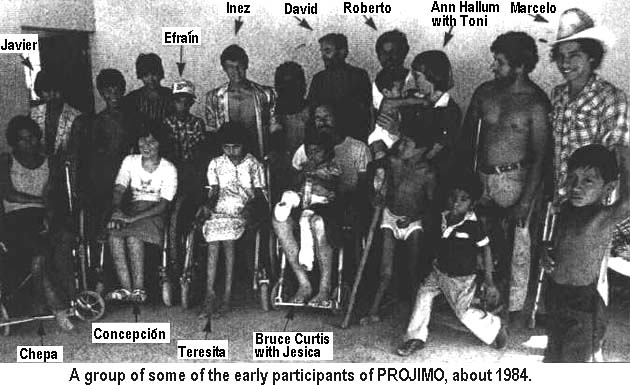
Note on the use of personal names in this book: Most
names used for the disabled children and adults in the stories are their
real names. However, to avoid confusion, we have occasionally used different
names for persons with the same names. We apologize for any confusion.
|
| 024
|
|

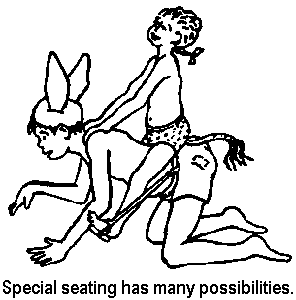 |
|